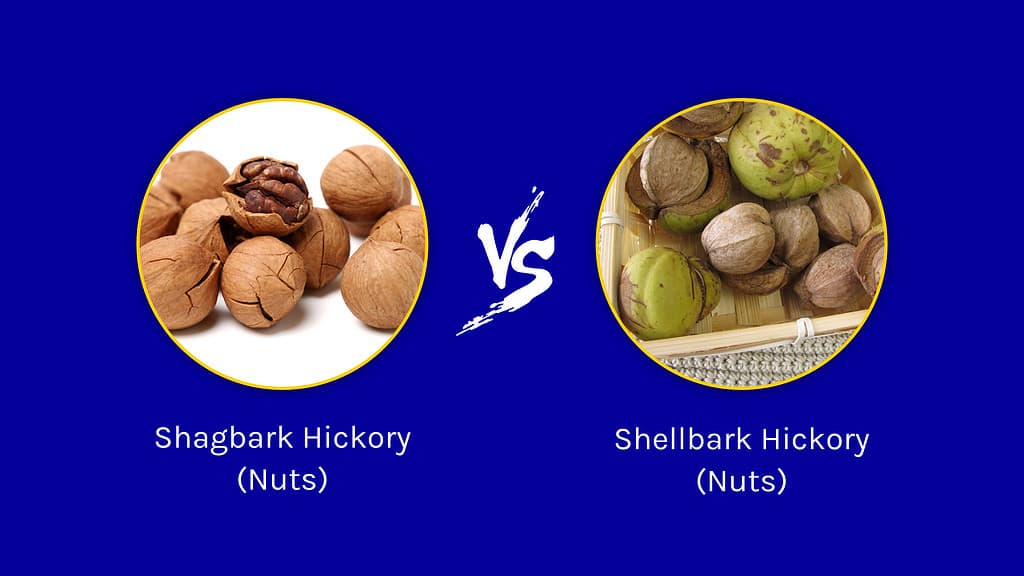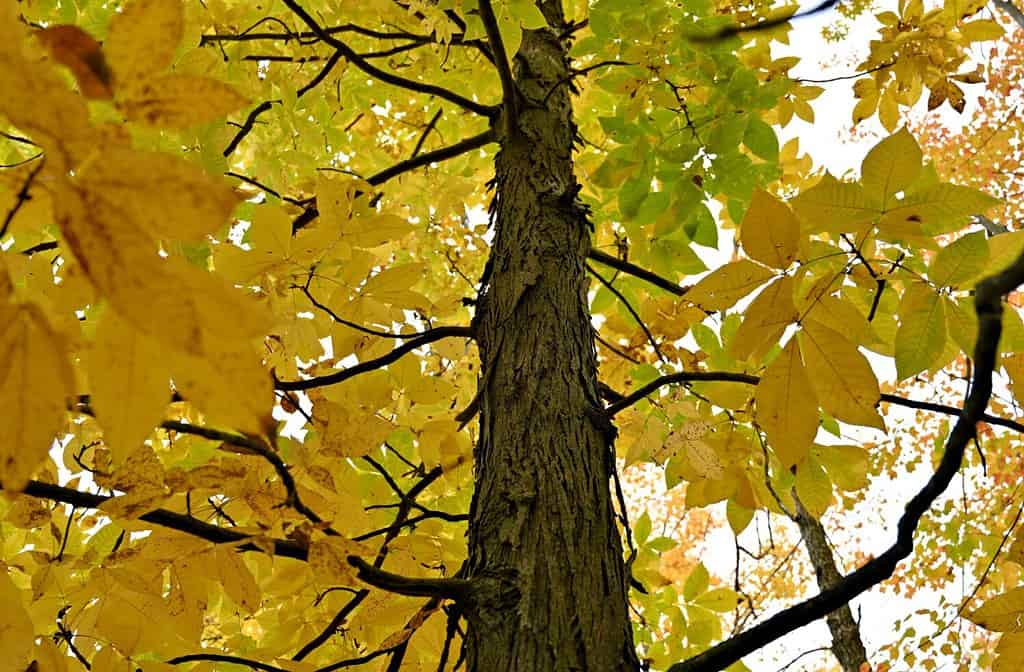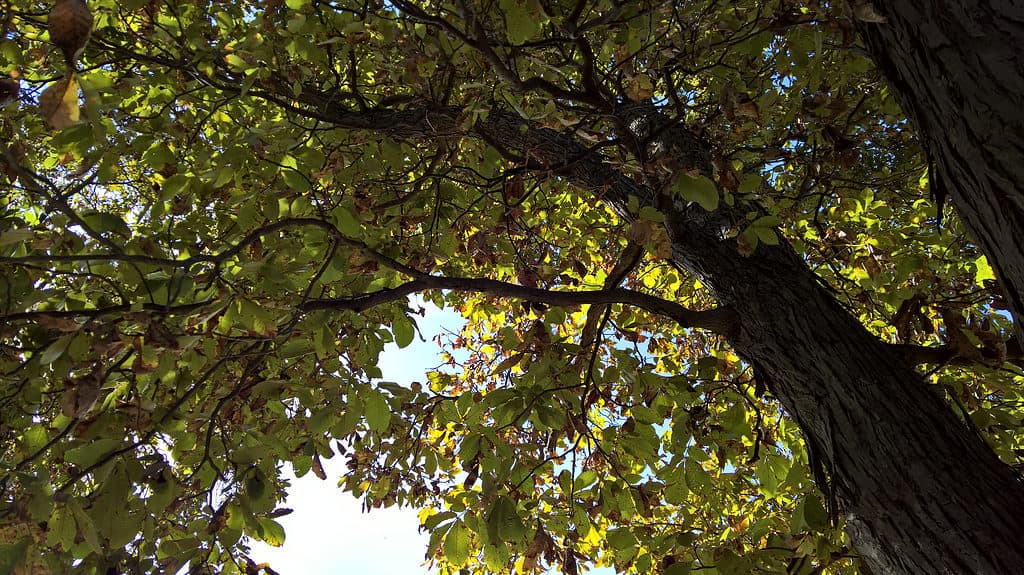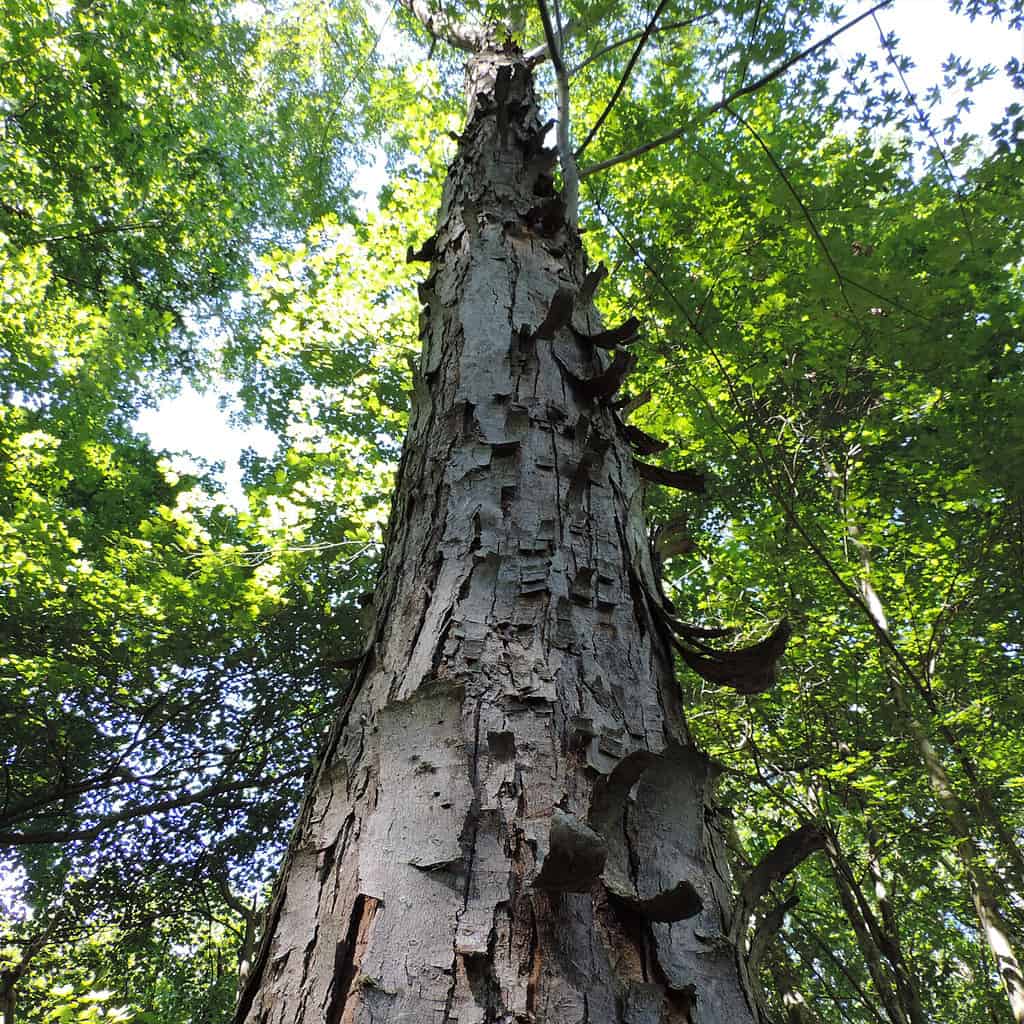Shagbark Hickory vs. Shellbark Hickory Tree: 10 Differences Between These Towering Giants
What is the difference between shagbark hickory and shellbark hickory trees? First, it may be helpful to outline a few basic similarities. Both shagbark and shellbark hickories are deciduous, which means they shed their leaves seasonally. They are also monoecious, meaning that each tree carries separate male and female reproductive components. In addition to this, both species have distinctive “shaggy” grey-brown bark that often leads observers to confuse the two. These similarities aside, there are a number of key differences between shagbark and shellbark hickories that may allow observers to tell them apart.

Summary Table: Shagbark Hickory vs. Shellbark Hickory Trees
| Classification | Kingdom: Plantae
Phylum: Magnoliophyta Division: Tracheophyta Class: Magnoliopsida Subclass: Hamamelidae Order: Fagales Family: Juglandaceae Genus: Carya Scientific Name: Carya ovata |
Kingdom: Plantae
Phylum: Magnoliophyta Division: Tracheophyta Class: Magnoliopsida Subclass: Hamamelidae Order: Fagales Family: Juglandaceae Genus: Carya Scientific Name: Carya laciniosa |
| Alternate Names | Carolina hickory, scalybark hickory, upland hickory | Kingnut, big shellbark, bottom shellbark, thick shellbark, western shellbark |
| Origin | Eastern/central US, southeast Canada | Mid-Atlantic/Midwest/southeast US, occasionally southeast Canada |
| Natural Habitat | Forest | Forest |
| USDA Hardiness Zone | Zones 4-8 | Zones 5-9 |
| Conservation Status in the US | Stable | Threatened (varies by state) |
| Height | Up to 130 feet (70-80 feet average) | Up to 131 feet |
| Shape | Upright trunks with branching further up | Upright trunks with branching further up |
| Foliage | Five leaflets, each 4-7 inches in length
Overall leaf length: 12-24 inches |
Seven to nine leaflets, each 5-9 inches in length
Overall leaf length: 12-24 inches |
| Wood | Loose-plated bark | Loose-plated bark |
| Nuts | 1.2 to 2.4 inches (3-6 centimeters)
Edible with nutty flavor |
Grows to 3 inches or more
Edible with sweet flavor |
| Uses | Landscaping, fuelwood, charcoal-producing wood, furniture, flooring, and tool handles
Nuts provide food for wildlife |
Fuelwood, charcoal-producing wood, furniture, tool handles, sporting goods, veneer
Nuts provide food for wildlife |
| Elevation Limit/Distance Above Sea Level | Upper elevation: 3,000 feet (910 meters)
Lower elevation: 2,000 feet (610 meters) |
Upper elevation: 985 feet (300 meters)
Lower elevation: 65 feet (20 meters) |
Shagbark Hickory vs. Shellbark Hickory: The 10 Key Differences

©Elmar Langle/Shutterstock.com
There are a number of key differences between shagbark hickory and shellbark hickory trees. These include classification, alternate names, distribution, USDA hardiness zones, conservation status, size, foliage, nuts, uses, and elevation.
1. Classification
Shagbark and shellbark hickory share the same classification right down to their genus, Carya. The approximately 18 species within Carya are commonly known as hickory trees. Although the two species are often confused, shagbark and shellbark hickory trees are distinct from one another. Their scientific names are as follows:
- Shagbark hickory: Carya ovata
- Shellbark hickory: Carya laciniosa
2. Alternate Names
The shagbark hickory also goes by the following alternate names: Carolina hickory, scalybark hickory, and upland hickory. The shellbark hickory is also known as the kingnut, big shellbark, bottom shellbark, thick shellbark, or western shellbark. Occasionally, the names “shagbark” and “shellbark” are mistakenly applied to the wrong species.
3. Origin/Distribution
Although there is overlap between their territories, shagbark and shellbark hickories vary in origin and distribution. Shagbark hickory occurs throughout the eastern and central US from southern Minnesota down to Texas and from eastern Nebraska to the Atlantic Coast. This species occurs in southeastern Canada as well, notably in the provinces of Ontario and Quebec. It also grows in patches of northern Mexico.
The shellbark hickory occurs in parts of the Mid-Atlantic, Midwest, and southeastern US states. This species also occurs in isolated areas of southeastern Canada, though this is less common.
4. USDA Hardiness Zones
There is some overlap between the USDA hardiness zones for shagbark and shellbark hickory trees. Shagbark hickories are hardy for zones 4-8 while shellbark hickories are hardy for zones 5-9.
5. Conservation Status

©iStock.com/Ethan R.
Shagbark hickory trees are more common than shellbark hickories and are stable in the United States. The status of shellbark hickory varies from state to state, with some states like New York designating it as a threatened species.
6. Size (Height/Diameter)
There is little difference in the heights of shagbark and shellbark hickories, with both reaching heights of up to 130 feet or so (approximately 40 meters). Most specimens are somewhat shorter than this, with mature shagbark hickories averaging 70-80 feet in height (21-24 meters). Shagbark hickories average 12-24 inches (30-61 centimeters) in diameter with a maximum reported diameter of 48 inches (122 centimeters). Shellbark hickories are slightly thinner with a maximum reported diameter of 39 inches (100 centimeters). Both hickory species are columnar, branching further up the trunk.
7. Foliage
The shagbark hickory has pinnate leaves with an average of five leaflets (occasionally three or seven) each measuring four to seven inches in length. The basal leaflets are much smaller than the three terminal leaflets. Overall leaf size is 12-24 inches long. The spread of the shagbark hickory is approximately 45 feet.
By contrast, the shellbark hickory often has between seven and nine leaflets measuring five to nine inches in length. Again, basal leaflets are smaller than terminal leaflets. Overall leaf size is 12-24 inches long. The spread of the shellbark hickory is approximately 50 feet.
8. Nuts
Both shagbark and shellbark hickories produce fruit in the form of oval nuts. Shagbark hickory nuts have a distinctive nutty flavor while the nuts of the shellbark hickory are slightly sweeter. The nuts of the shagbark are 1.2 to 2.4 inches (3-6 centimeters) in size while shellbark nuts grow up to three inches or more. The shellbark hickory is also known as the kingnut hickory because its nuts are larger than those of other hickories.
9. Uses

©Emilio C/Shutterstock.com
Hickory wood is unmatched in terms of its durability, strength, hardness, and stiffness, making it extremely useful in a variety of applications. The wood of shagbark hickories is useful in the production of furniture, flooring, and tool handles and can also be used for fuelwood and charcoal-producing wood. Additionally, shagbark trees have been known to make pleasant additions to large-scale landscaping. Shellbark hickory wood is similarly useful as furniture, tool handles, sporting goods, veneers, fuelwood, and charcoal-producing wood.
The nuts of both tree species are edible, providing food to wildlife and (occasionally) livestock. Some animals that eat hickory nuts include:
- Squirrels
- Chipmunks
- Black bears
- Foxes
- Rabbits
- White-footed mice
- Raccoons
- Deer
- Mallards
- Wood ducks
- Bobwhites
- Quail
- Wild turkeys
10. Elevation
Shagbark hickory typically grows at high elevations between 2,000 feet (610 meters) and 3,000 feet (910 meters). By contrast, shellbark hickory grows at much lower elevations, typically between 65 feet (20 meters) and 985 feet (300 meters).









